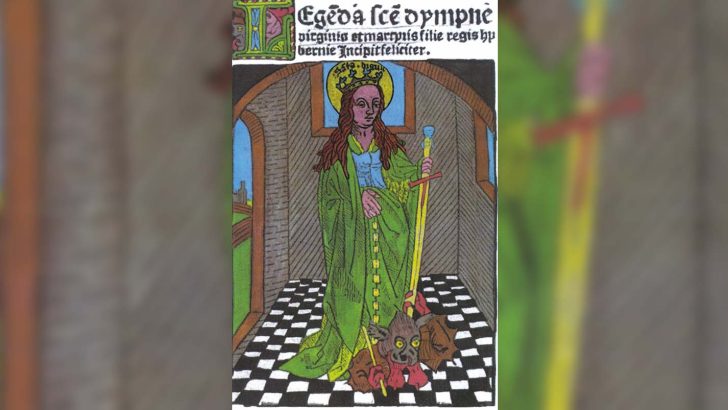Davnet and Dympna: A Single Cult by Seosamh Ó Dufaigh
(Clogher Historical Society, €30.00; website: www.clogherhistory.ie)
The tradition about St Dympna of Oriel (the ancient territory now covered by the Dioceses of Armagh and Clogher) was that she was the beautiful daughter of the local king in the 7th Century. His wife died early and his kinsmen suggested he cure his great grief by marrying again. But rather than that he turned his unmassaged urges towards his 15-year-old daughter, in whom he could see the passing image of his dead wife’s beauty.
Fled
She resisted his unnatural lust and fled with some servants, making her way to Geel in northern Belgium. There he tracked her down, and rejected yet again, he beheaded her. It was on the continent that her name and devotion emerged to wide view in the 13th Century, but the cult owes its origins undoubtedly to Oriel.
Today Dympna is the patron saint of the mentally-ill and the victims of incest abuse; and Geel, also known as Gheel, back in the middle ages developed a system of ‘care in the community’ which still exists to this day, and is an example to the world.
“Mention of Dympna of Gheel,” the author writes in his introduction, “reminds us that Davnet of Tydavnet has a double persona and that their association is centuries old. As the weight of study and research has been given to the cult of the Gheel saint (in Belgium but not in Ireland), this volume attempts to redress this imbalance and to focus more on the saint of Tydavnet.
Process
“In the process,” he concludes “a third personage has insinuated herself into the arena who, far from creating further confusion, makes space for a common reference point in the remote pagan past. This is the goddess Damona, the pre-Christian dimension of both Davnet and Dympna and a possible source of uniting them in the popular mind with the historical Maugina of Clogher and Cloonburren by the Shannon. The daunting task here is to maintain the distinction between history and mythology, to keep discerning one from the other, in the search for remains of a single cult already in existence”.
If all that does not sound problematic enough, there is more. There was also the change from Gaelic to English and with it the importation of new religious elements over time. But no matter how confusing it may seem initially it is all part of the intricate network of Irish history and its inter-linguistic, inter- cultural connections.
Revealed
So the two saints are revealed here to be in reality a single religious continuity. Seosamh Ó Dufaigh has written an immensely important book which has taken many years of research to bring to shape. And as he states his conclusions, which are open everywhere to revision and enlargement, he can rightly take a well-earned pause, before returning to his ancient volumes, field notes, and index cards.
While aimed at the 800 very active members of the Clogher Historical Society, many copies of this book will be snapped up by libraries and readers in many other places. Congratulations are in order for the author and his associates, who will be an example to those in other such societies around the country.
The book comes, by the way, with extensive footnotes, bibliographies, and some fine colour photographs, often of unfamiliar shrines of ancient times. It volume runs 240 large format pages, so that the actual text in two columns amounts to about 500 pages of an ordinary book. It is beautifully bound, and costs €30. It’s available now directly from the Clogher Historical Society.
Connections
Dedications and connections to Davnet/Dympna are spread in an irregular way across Mayo, Donegal, and Clogher of course; but also Louth, the midlands and down to Wexford.
The last chapter of his text is, I think unusual in the context of a local history book. Naturally the explorations and suggestions in this book will be of vital and inspiring influence on current and future researchers.
But also of striking importance is the final chapter of the book (before the various appendices) which is entitled ‘For today and tomorrow’ and which gives the relevance of the saint for the care and fostering of the mentally afflicted in the past and today and in the future. This is an usually pastoral discussion to find in a book largely devoted to local and ecclesiastical history. But it is very inspiring and so very relevant if unusual.
Abuse
The question of sexual abuse in the life of the saint is very relevant to some of the most hotly debated matter of our own day. In this chapter the author underlines the striking relevance of what we can learn about the past to how we create the future today. The author is already deeply aware of the psychological problems that face Christians in Ireland, but also the Churches as institutions.
The failures we have been made aware of, but that we now turn to healing, as indicated in the traditions at Gheel, is also vital.


 Peter Costello
Peter Costello A woodcut of St Dympna, created in Antwerp in 1496.
A woodcut of St Dympna, created in Antwerp in 1496. 